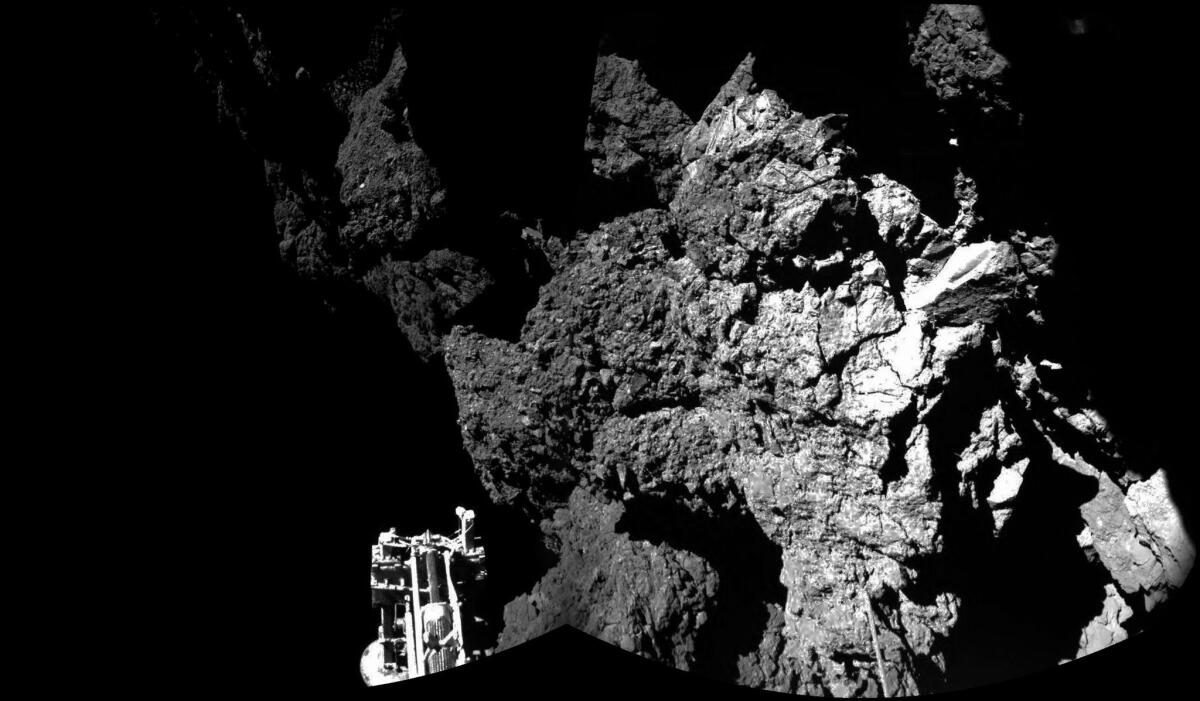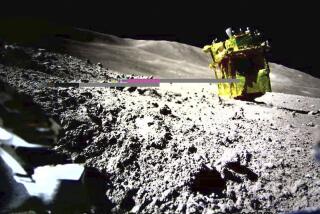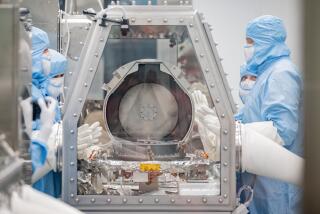European spacecraft lands on comet, with a bounce

- Share via
A mobile laboratory the size of a washing machine made history Wednesday when it completed a slow-motion descent to the surface of a comet 311 million miles from Earth.
But scientists fear it didn’t stick the landing.
The European Space Agency’s Philae spacecraft initially landed close to its target site on the comet and beamed back its position to the Rosetta orbiter. ESA engineers headquartered in Darmstadt, Germany, received the first signal that the lander had made it to the surface after a long and agonizing wait.
Scientists had slammed spacecraft into comets before, but had never gently landed on one. The ESA team conceived the risky Rosetta mission in the late 1980s to learn more about comets that formed from the same mix of gas, dust and other ingredients that would form the sun, Earth and other planets.
The Rosetta orbiter was launched in 2004 with the Philae lander strapped to its side. Together, they flew around the inner solar system on a looping trajectory that took them past Earth three times, past Mars once, and through the asteroid belt twice. After nearly 4 billion miles and 10 years of space travel, including an unprecedented three-year hibernation, they finally met up with their target, 67P/Churyumov-Gerasimenko, in August.
Since then, the spacecraft and the comet have been moving through space together, barreling toward the sun at 34,400 mph. They will make their closest approach in August 2015, then fly back beyond the orbit of Jupiter.
Rosetta has become a signature mission for ESA, with half a million people tracking the landing online. NASA considered a similar mission years ago, but it was deemed too ambitious at a time when the space agency’s budgets were being slashed, said Claudia Alexander of the Jet Propulsion Laboratory and the agency’s head liaison for the Rosetta mission.
It took Philae seven hours to drop 14 miles from the orbiter to the 2.5-mile-wide hulk of dust and ice.
“We are on the comet!” Stephan Ulamec, the Philae lander manager at ESA, announced to an auditorium filled with cheering scientists and engineers.
Just hours after Philae touched down, scientists reported that its landing had been more gentle than expected and that the craft had settled onto a soft terrain of powder 1.5 inches deep. Philae also sent back stunning images of its new, icy home, which were captured less than 2 miles above the comet’s surface.
But the initial enthusiasm was soon tempered by the realization that two harpoons designed to tether Philae to 67P failed to deploy. Without the harpoons, the lander could tumble around the comet, whose gravity is only 1/60,000th as strong as that on Earth.
ESA officials said the data sent back by Philae suggest it had already started to bounce.
“One way to interpret that is that the lander touched down and then recoiled up,” said Karl Battams, who studies comets at the U.S. Naval Research Laboratory and traveled to Darmstadt for the landing.
He added that although Philae weighs 220 pounds on Earth, on the surface of the mountain-sized comet it weighs just one gram — about as much as a penny cut in half.
ESA engineers are analyzing the data for any clues that can tell them exactly what happened.
“It’s complicated to land on a comet,” Ulamec said. “It’s also, as it appears, very complicated to understand what has happened during this landing. Maybe today, we didn’t just land once, we even landed twice.”
Even before the lander was deployed from Rosetta, ESA engineers knew there could be some technological hiccups. Last-minute tests revealed that they could not activate a jet atop the lander that was supposed to help keep it on the comet immediately after touchdown.
Officials decided to proceed with the landing anyway because Philae had two other ways to help it stick to the comet — the two harpoons and a set of six-inch ice drills on the lander’s feet that were designed to screw it into the surface.
Then it turned out the harpoons didn’t activate either.
It does seem that the ice drills worked properly, but it is not clear how effective they will be at keeping the lander in place, said Mark Hofstadter, a planetary scientist at JPL and the deputy principal investigator for the MIRO instrument on the Rosetta orbiter, which studies the comet’s nucleus and surrounding coma.
“Those ice screws were there in case we landed on something really hard, like exposed rock or a sheet of ice,” Hofstadter said. “They won’t help you much if you land in a pile of sand or dust.”
Despite these setbacks, scientists around the world were overjoyed by the achievement.
“This is a great, great day,” said Jean-Jacques Dordain, director general of the European Space Agency.
Jim Green, planetary science director for NASA, called the mission audacious and exciting: “How unbelievable to be able to dare to land on a comet, to take that step that we have all wanted from a scientific perspective.”
Scientists said measurements taken by Rosetta and Philae will broaden not just their knowledge of 67P, but of other comets as well.
“Rosetta will help us understand all the remote telescope observations we have of hundreds of other comets, which are different from one another,” said Michael Combi, a comet scientist at the University of Michigan. “What we learn about this one comet will give us the real ground truth so we can calibrate past and future observations of other types of comets.”
In its three-month stint escorting the comet, Rosetta’s instruments have mapped 67P’s gravity fields and examined the areas from which its gas jets appear to spring. They’ve also determined the precise mix of molecules in the gas cloud around its nucleus.
With the Philae lander, scientists hope to get even more up close and personal with the comet — taking its temperature, sampling its dust and sending back panoramic views of its inky black landscape.
Although the Philae aspect of the Rosetta mission has captured the public’s imagination, measurements collected by the lander were expected to make up just 20% of the total science data.
Even before the landing difficulties, Philae’s expected tenure on the comet surface was unknown. It has enough battery power to conduct experiments on 67P for about 60 hours. After that, it must get power from solar panels on its boxy body.
But nobody knows whether the gas and dust emitted by the comet will interfere with the solar panels’ ability to collect sunlight.
“This mission is just getting started,” Hofstadter said. “And regardless of what happens, we have a healthy orbiter ready to operate for the next year and a half in close proximity to a comet.”
Twitter: @DeborahNetburn
Times staff writer Christine Mai-Duc contributed to this report.







